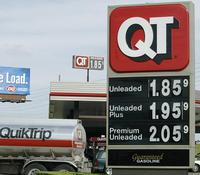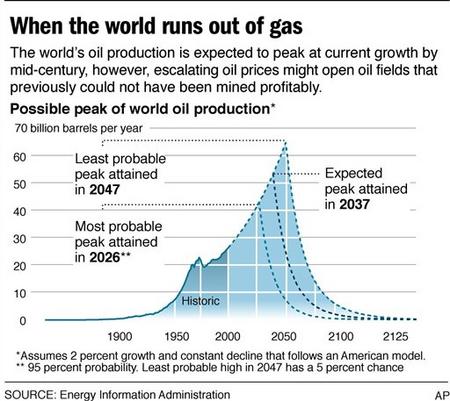Untitled Document
Could the petroleum joyride - cheap, abundant oil that has sent the global economy
whizzing along with the pedal to the metal and the AC blasting for decades - be
coming to an end? Some observers of the oil industry think so. They predict that
this year, maybe next - almost certainly by the end of the decade - the world's
oil production, having grown exuberantly for more than a century, will peak and
begin to decline.
And then it really will be all downhill. The price of oil will increase drastically.
Major oil-consuming countries will experience crippling inflation, unemployment
and economic instability. Princeton University geologist Kenneth S. Deffeyes
predicts "a permanent state of oil shortage."
According to these experts, it will take a decade or more before conservation
measures and new technologies can bridge the gap between supply and demand,
and even then the situation will be touch and go.
None of this will affect vacation plans this summer - Americans can expect
another season of beach weekends and road trips to Graceland relatively unimpeded
by the cost of getting there. Though gas prices are up, they are expected to
remain below $2.50 a gallon. Accounting for inflation, that's pretty comparable
to what motorists paid for most of the 20th century; it only feels expensive
because gasoline was unusually cheap between 1986 and 2003.
And there are many who doubt the doomsday scenario will ever come true. Most
oil industry analysts think production will continue growing for at least another
30 years. By then, substitute energy sources will be available to ease the transition
into a post-petroleum age.
"This is just silly," said Michael Lynch, president of Strategic
Energy and Economic Research in Winchester, Mass. "It's not like industrial
civilization is going to come crashing down."
Where you stand on "peak oil," as parties to the debate call it,
depends on which forces you consider dominant in controlling the oil markets.
People who consider economic forces most important believe that prices are high
right now mostly because of increased demand from China and other rapidly growing
economies. But eventually, high prices should encourage consumers to use less
and producers to pump more.
But Deffeyes and many other geologists counter that when it comes to oil, Mother
Nature trumps Adam Smith. The way they see it, Saudi Arabia, Russia, Norway
and other major producers are already pumping as fast as they can. The only
way to increase production capacity is to discover more oil. Yet with a few
exceptions, there just isn't much left out there to be discovered.
"The economists all think that if you show up at the cashier's cage with
enough currency, God will put more oil in ground," Deffeyes said.
There will be warning signs before global oil production peaks, the bearers
of bad news contend. Prices will rise dramatically and become increasingly volatile.
With little or no excess production capacity, minor supply disruptions - political
instability in Venezuela, hurricanes in the Gulf of Mexico or labor unrest in
Nigeria, for example - will send the oil markets into a tizzy. So will periodic
admissions by oil companies and petroleum-rich nations that they have been overestimating
their reserves.
Oil producers will grow flush with cash. And because the price of oil ultimately
affects the cost of just about everything else in the economy, inflation will
rear its ugly head.

Anybody who has been paying close attention to the news lately may feel a bit
queasy at this stage. Could $5-a-gallon gas be right around the corner?
"The world has never seen anything like this before and so we just really
don't know," said Robert L. Hirsch, an energy analyst at Science Applications
International Corp., a Santa Monica, Calif., consulting firm.
Still, he added, "there's a number of really competent professionals that
are very pessimistic."
The pessimism stems from a legendary episode in the history of petroleum geology.
Back in 1956, a geologist named M. King Hubbert predicted that U.S. oil production
would peak in 1970.
His superiors at Shell Oil were aghast. They even tried to persuade Hubbert
not to speak publicly about his work. His peers, accustomed to decades of making
impressive oil discoveries, were skeptical.
But Hubbert was right. U.S. oil production did peak in 1970, and it has declined
steadily ever since. Even impressive discoveries such as Alaska's Prudhoe Bay,
with 13 billion barrels in recoverable reserves, haven't been able to reverse
that trend.
Hubbert started his analysis by gathering statistics on how much oil had been
discovered and produced in the Lower 48 states, both onshore and off, between
1901 and 1956 (Alaska was still terra incognita to petroleum geologists 50 years
ago). His data showed that the country's oil reserves had increased rapidly
from 1901 until the 1930s, then more slowly after that.
When Hubbert graphed that pattern it looked very much like America's oil supply
was about to peak. Soon, it appeared, America's petroleum reserves would reach
an all-time maximum. And then they would begin to shrink as the oil companies
extracted crude from the ground faster than geologists could find it.
That made sense. Hubbert knew some oil fields, especially the big ones, were
easier to find than others. Those big finds would come first, and then the pace
of discovery would decline as the remaining pool of oil resided in progressively
smaller and more elusive deposits.
The production figures followed a similar pattern, but it looked like they
would peak a few years later than reserves.
That made sense too. After all, oil can't be pumped out of the ground the instant
it is discovered. Lease agreements have to be negotiated, wells drilled, pipelines
built; the development process can take years.
When Hubbert extended the production curve into the future it looked like it
would peak around 1970. Every year after that, America would pump less oil than
it had the year before.
If that prognostication wasn't daring enough, Hubbert had yet another mathematical
trick up his sleeve. Assuming that the reserves decline was going to be a mirror
image of the rise, geologists would have found exactly half of the oil in the
Lower 48 when the curve peaked. Doubling that number gave Hubbert the grand
total of all recoverable oil under the continental United States: 170 billion
barrels.
At first, critics objected to Hubbert's analysis, arguing that technological
improvements in exploration and recovery would increase the amount of available
oil.
They did, but not enough to extend production beyond the limits Hubbert had
projected. Even if you throw in the unexpected discovery of oil in Alaska, America's
petroleum production history has proceeded almost exactly as Hubbert predicted
it would.
Critics claim that Hubbert simply got lucky.
"When it pretty much worked," Lynch said, "he decided, aha,
it has to be a bell curve."
But many experts see no reason global oil production has to peak at all. It
could plateau and then gradually fall as the economy converts to other forms
of energy.
"Even in 30 to 40 years there's still going to be huge amounts of oil
in the Middle East," said Daniel Sperling, director of the Institute of
Transportation Studies at the University of California, Davis.
A few years ago, geologists began applying Hubbert's methods to the entire
world's oil production. Their analyses indicated that global oil production
would peak some time during the first decade of the 21st century.
Deffeyes thinks the peak will be in late 2005 or early 2006. Houston investment
banker Matthew Simmons puts it at 2007 to 2009. California Institute of Technology
physicist David Goodstein, whose book "The End of Oil" was published
last year, predicts it will arrive before 2010.
The exact date doesn't really matter, said Hirsch, because he believes it's
already too late. In an analysis he did for the U.S. Department of Energy in
February, Hirsch concluded that it will take more than a decade for the U.S.
economy to adapt to declining oil production.
"You've got to do really big things in order to dent the problem. And
if you're on the backside of the supply curve you're chasing the train after
it's already left the station," he said.
For example, the median lifetime of an American automobile is 17 years. That
means even if the government immediately mandated a drastic increase in fuel
efficiency standards, the conservation benefits wouldn't fully take effect for
almost two decades.
And though conservation would certainly be necessary in a crisis, it wouldn't
be enough. Fully mitigating the sting of decreasing oil supplies would require
developing alternate sources of energy - and not the kind that politicians and
environmentalists wax rhapsodic about when they promise pollution-free hydrogen
cars and too-cheap-to-meter solar power.
If oil supplies really do decline in the next few decades, America's energy
survival will hinge on the last century's technology, not the next one's. Hirsch's
report concludes that compensating for a long-term oil shortfall would require
building a massive infrastructure to convert coal, natural gas and other fossil
fuels into combustible liquids.
Proponents of coal liquefaction, which creates synthetic oil by heating coal
in the presence of hydrogen gas, refer to the process as "clean coal"
technology. It is clean, but only to the extent that the synthetic oil it produces
burns cleaner than raw coal. Synthetic oil still produces carbon dioxide, the
main greenhouse warming gas, during both production and combustion (though in
some scenarios some of that pollution could be kept out of the atmosphere).
And the coal that goes into the liquefaction process still has to be mined,
which means tailing piles, acid runoff and other toxic ills.
And then there's the fact that nobody wants a "clean coal" plant
in the backyard. Shifting to new forms of energy will require building new refineries,
pipelines, transportation terminals and other infrastructure at a time when
virtually every new project faces intense local opposition.
Energy analysts say coal liquefaction can produce synthetic oil at a cost of
$32 a barrel, well below the $50 range where oil has been trading for the past
year or so. But before they invest billions of dollars in coal liquefaction,
investors want to be sure that oil prices will remain high.
Investors are similarly wary about tar sands and heavy oil deposits in Canada
and Venezuela. Though they are too gooey to be pumped from the ground like conventional
oil, engineers have developed ways of liquefying the deposits with injections
of hot water and other means. Already, about 8 percent of Canada's oil production
comes from tar sands.
Unfortunately, it costs energy to recover energy from tar sands. Most Canadian
operations use natural gas to heat water for oil recovery; and like oil, natural
gas has gotten dramatically more expensive in the past few years.
"The reality is, this thing is extremely complicated," Hirsch said.
"My honest view is that anybody who tells you that they have a clear picture
probably doesn't understand the problem

